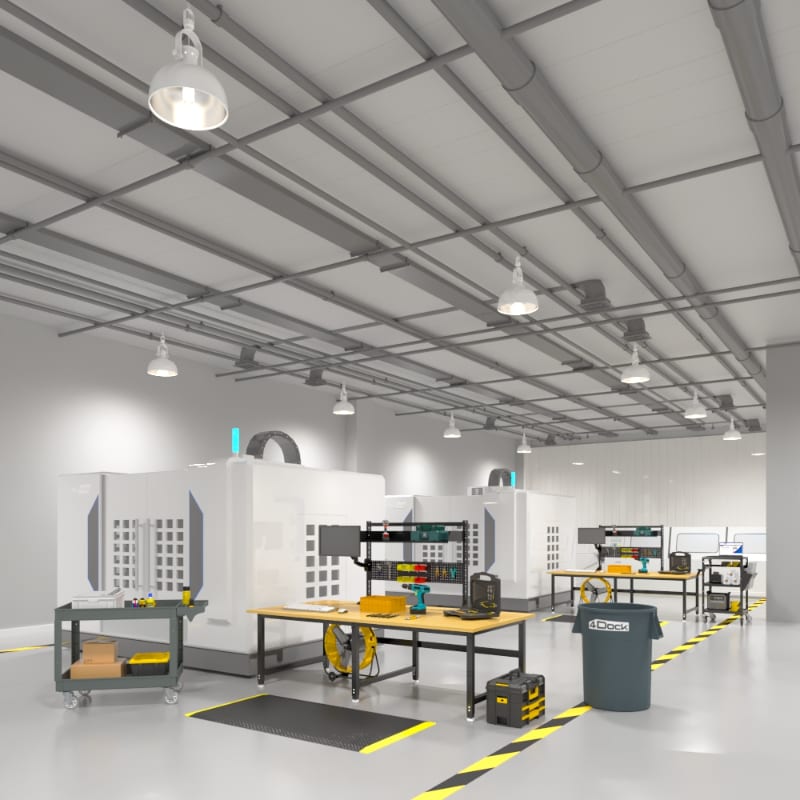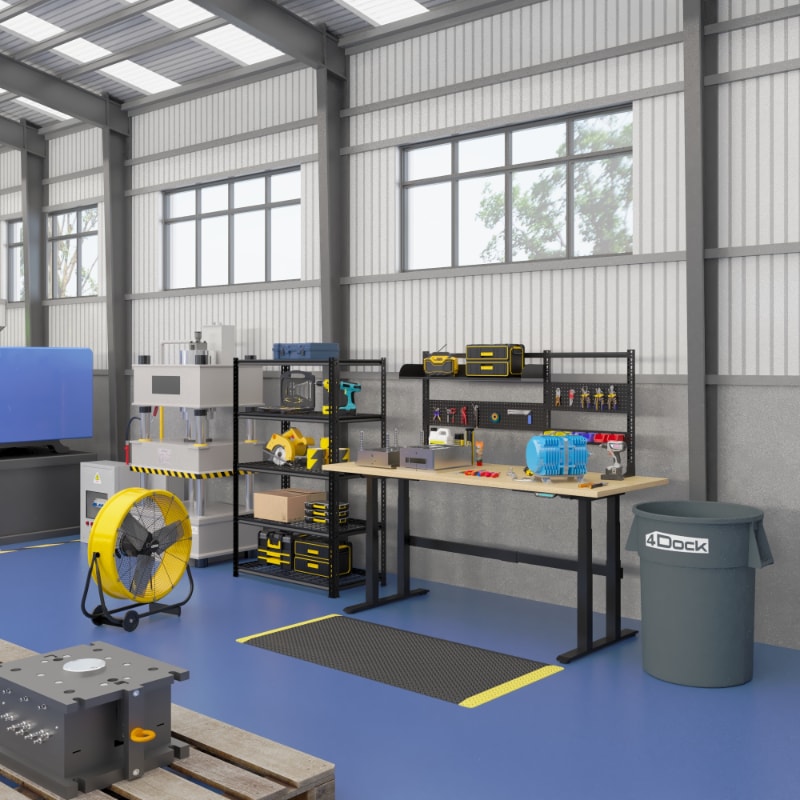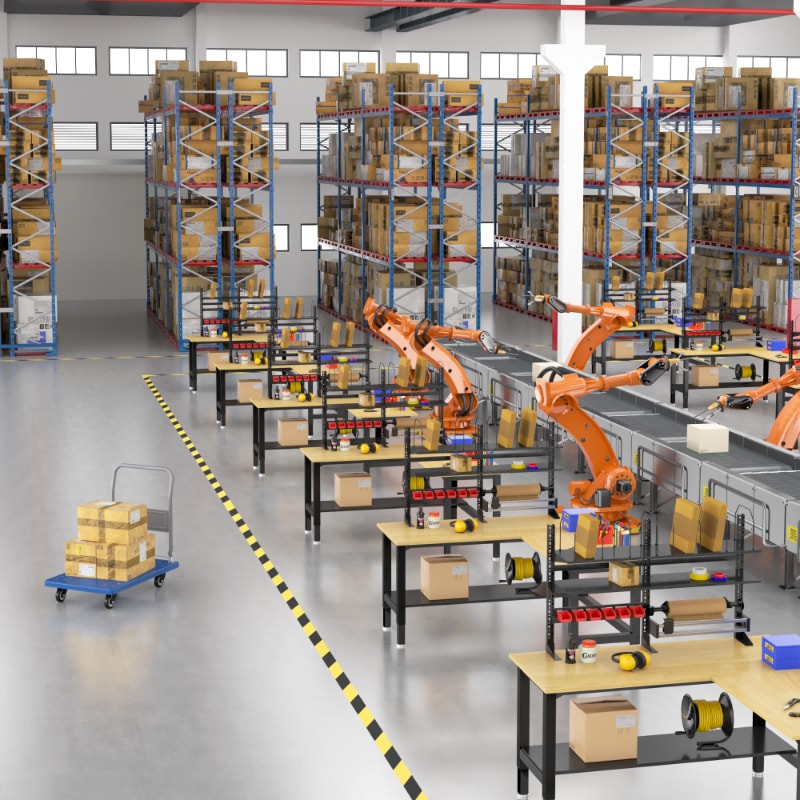In industrial environments such as warehouses, manufacturing plants, and repair facilities, ergonomics is not just a comfort upgrade—it’s a critical driver of productivity and safety. Studies show that poor ergonomic design is a leading cause of musculoskeletal disorders (MSDs), accounting for up to 34% of days away from work in manufacturing and nearly 30% of all workplace injuries. Implementing ergonomic workstations can reduce MSD-related absences by as much as 72% and increase productivity by approximately 46%. Well-designed ergonomic interventions often yield a return of $3–$6 for every dollar spent. At 4Dock, we believe that a properly chosen industrial workbench can significantly reduce repetitive strain, minimize injury risk, and enhance workflow efficiency, ensuring better posture and performance during long shifts of packing, assembly, or inspection. But how do you choose the right one? This guide will help you navigate key workbench types, selection criteria, and application-specific recommendations to find your perfect fit.
Types of Industrial Workbenches
Heavy-Duty Packing Tables
These heavy-duty workbenches are built for speed, efficiency, and volume. With reinforced steel frames, spacious work surfaces (often 60"–96" wide), and optional add-ons like upper shelves, carton dividers, and reel holders, packing tables are a staple in warehouses and fulfillment centers. Their static design ensures stability under high throughput, making them ideal for repetitive packing, labeling, and shipping tasks.
Best for: Warehouses, eCommerce fulfillment zones, 3PL operations.
Key features: Wide surface, modular accessories, high load capacity

Electric Height Adjustable Workbenches
Combining industrial strength with ergonomic performance, these benches feature electric motors that smoothly raise or lower the work surface at the push of a button. With a range typically between 23"–49", they support a full sit-stand workflow and accommodate multiple users throughout the day. Built-in anti-collision and overload protection features ensure safety in dynamic environments.
Best for: Assembly lines, electronics repair, quality inspection.
Key features: Programmable height presets, ergonomic compliance, low-noise operation
Hand-Crank Adjustable Workbenches
These workbenches offer ergonomic benefits without the price tag of electric systems. A side-mounted crank enables manual adjustment of height, usually from 28" to 38". Though not as fast or effortless as electric lift benches, they provide reliable adaptability for multi-user stations with lower daily adjustment frequency.
Best for: Technical workshops, labs, schools, mechanical service areas.
Key features: Cost-effective ergonomics, durable steel frames, easy maintenance

Mobile Workbenches with Lockable Casters
When flexibility is key, mobile workbenches offer the ability to reconfigure your workspace on demand. Equipped with heavy-duty casters and brakes, these benches can be easily relocated across work zones. Some models include power strips or storage drawers, making them a self-contained workstation.
Best for: Tool rooms, maintenance departments, prototyping areas.
Key features: Repositionable, compact footprint, optional storage
L-Shaped & Corner Workbenches
Designed to maximize corner spaces and provide extended workflow surfaces, L-shaped benches are perfect for multitasking environments. These workstations often support dual operators and can be configured with power and data integration, shelving, and lighting for high-efficiency operations.
Best for: Work cells, dual-user stations, electronics assembly.
Key features: Large footprint, modular layout, multi-zone organization

What to Look for in an Industrial Workbench
Whether you're outfitting a fast-moving fulfillment center or an engineering lab with specialized tools, choosing the right industrial workbench means balancing performance, efficiency, and long-term value. Here's how to evaluate the key decision factors:
1. Load Capacity That Matches Your Workflow
The right workbench should safely support the tools, parts, and processes in your daily operations.
- Light-duty (≤ 500 lbs / ~225 kg): Ideal for electronics assembly or light packing tasks. In electronic assembly plants, machines and components typically weigh around 200 kg (≈ 440 lbs)
- Medium-duty (500–1,000 lbs / ~225–450 kg): Suitable for mixed use—tools, parts bins, or labelers. Common warehouse benches in Europe support up to 500 kg UDL (~1,100 lbs)
- Heavy-duty (1,000 lbs+ / ~450 kg+): Built for heavy equipment like vises, industrial tools, or bulk materials. Some heavy-duty workbenches support up to 5,000 lbs, though capacity may drop to ~4,000 lbs when the bench is wider (e.g., 96") .
- Always check the UDL (Uniformly Distributed Load) rating — avoid central sagging or overloading risks.
✅ Tip: For warehouses or mechanical repair bays, 1,200–3,000 lbs is the safe starting point.
2. Materials That Suit Your Environment
Different top and frame materials are optimized for different industries:
- Powder-Coated Steel Frame: Most durable for industrial use; corrosion-resistant, low maintenance
- Rubberwood / Maple Top: Ideal for absorbing vibration in repair or light assembly work
- Stainless Steel Top: Great for cleanrooms, food production, or labs (hygienic, chemical-resistant)
- ESD Laminate or Particleboard: Cost-efficient for electronics or packaging stations
✅ Choose surfaces based on exposure to solvents, oils, heavy impact, or static sensitivity.
3. Proper Sizing & Workspace Planning
Match your workbench layout to your floor space and task type.
- Length: From compact 48" to expansive 96"+ models
- Depth: 24–36" for general use; up to 48" for large components
- Height: Fixed height (~34") vs. adjustable (29"–37") for ergonomic customization
- L-Shaped / U-Shaped Configurations: Efficient for dual-operator or assembly line stations
✅ Always leave 36–42" of clearance around the bench for safe movement and equipment access.
4. Ergonomics & Height Adjustability
Workstations that support human movement reduce fatigue and lower injury risks. According to OSHA, poor ergonomics contribute to 33% of work-related injuries.
- Electric height-adjustable legs offer fast, quiet, programmable positioning
- Manual crank options allow flexibility on a budget
- Consider anti-fatigue mats, footrests, and edge protectors to further enhance comfort
✅ Sit-stand flexibility is especially valuable in multi-shift environments or aging workforce contexts.
5. Storage & Organization Features
Integrated storage improves task speed and tool tracking:
- Drawers: For small hand tools or accessories
- Shelves: Ideal for parts bins, tape rolls, or packaging
- Pegboards: For vertical tool hanging and easy visual access
- Cabinets or lockboxes: For secure inventory like power tools or electronics
✅ Use high-frequency tools within arm’s reach (28–34") and bulk storage below the tabletop line.
6. Mobility & Reconfigurability
Mobile workbenches allow your workspace to evolve as production scales or shifts.
- Locking casters (4–6") rated 250–500 lbs each for stability on concrete floors
- Swivel wheels allow full mobility in tight areas; front-lock wheels prevent rolling during use
- Some models include handles or brake levers for safety
✅ In lean manufacturing or prototyping areas, modular mobility saves time and space.
7. Smart Features & Add-Ons That Scale with You
Think beyond the surface — many workbenches now support plug-and-play upgrades:
- Power strips & USB hubs for powering tools or charging devices
- LED lighting arms reduce eye strain for detailed work
- Reel holders & paper roll dispensers for packing lines
- Back panels, edge guards, or adjustable risers for organizing and safety
✅ Future-proof your investment with a model that supports accessory rails or integrated uprights.
Final Thoughts
Selecting the right industrial workbench is more than a matter of size or material—it’s about designing a workspace that supports your team’s safety, efficiency, and long-term health. Whether you're outfitting a high-volume warehouse, a precision repair bench, or a modular production cell, the right workbench can reduce injuries, streamline workflows, and support ergonomic best practices backed by real-world data.Take the time to assess your workflow, load requirements, and space limitations. Think about who will use the bench, what tasks they'll perform, and how their needs might evolve over time. From heavy-duty packing tables to advanced electric lift stations, there’s a solution designed for your exact environment.Want help building a better industrial workspace? Explore 4Dock’s full range of industrial workstations or talk to one of our specialists for a tailored recommendation.

